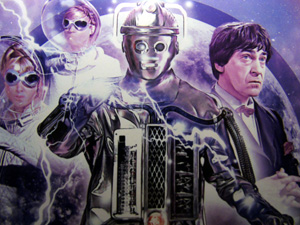The Moonbase
“I don’t know how many more of these Cybermen there are, but from our point of view we are under siege.” – Hobson
The first proper base-under-siege story for the Troughton era which would become a staple of his tenure—specifically the TARDIS crew arrive at a remote location (here the moon) just as strange occurrences are starting to happen to the resident group (in this case a deadly virus) and must help when it turns out to be a full-scale assault and invasion by alien forces (in this case the first return of the Cybermen). This story is a notable step forward for making the Cybermen a regularly recurring set of villains for the show, giving them more build-up and menace, especially their threatening broadcasts in electronic monotone and their impressive march across the surface of the moon. They are also given a broader but not too detailed history that could be used for the future stories. (“There were Cybermen, every child knows that, but they were all destroyed ages ago.”) They already know the Second Doctor in this story but it must be later in his timeline. Like their first story, the Cybermen’s lack of feelings is emphasized by their casual disregard for life (no need for protective gear for their slaves since they calculate their bodies will not give out until just after their needed timeframe) and their wonder at the idea that their plan to destroy humanity has an element of revenge since this is an emotion they don’t possess.
This story was written by Kit Pedler, the same writer who created the idea of the Cybermen based on his background in medical science; he introduces several other interesting scientific elements like the moon-based Gravitron that controls the weather of 2070 Earth and the neurotropic virus that infects the base (with some surprisingly good effects to show it spreading darkly under the skin—I’m very glad that at least one episode remains intact for us to see that). The Cybermen also get a bit of an upgrade in design—as they will continue to do throughout their appearances on the show—and are much more metallic based here. Yet some parts are apparently plastic and susceptible to the solvents that the companions bravely wield in an assault against the first wave. As the Doctor points out, “Everything’s got a weak point. It’s just a question of waiting until it shows up, that’s all.” We can presume that these weaknesses get discovered and fixed with every upgrade, however, since the famous “Polly cocktails” never get used again.
I really like that we get a subtle early clue to the sugar being the source of the virus from the bags in the pantry being punctured. Other little interesting bits include a swipe at silly bureaucrats—even we as viewers feel bitter towards the controller pedantically telling the assaulted moon base “I think perhaps you don’t appreciate how serious the situation already is”—and a scene with the Doctor wondering to himself about the Cybermen’s plans that switches between us hearing his thoughts and his spoken words. This story also gives one of the Second Doctor’s most famous quotes: “There are some corners of the universe which have bred the most terrible things. Things which act against everything that we believe in. They must be fought.”
Best (or worst) unsettling moments:
When the rescue ship is blasted off course towards the sun it’s obviously tragic, but it’s even more horrific when Benoit points out that the ship and crew will not immediately be destroyed. They are trapped in a gravity pull and “it may take a week but they’ll end up there just the same,” plunging into the sun. The idea of that innocent crew having that week to see their inevitable doom coming is quite unsettling.
The reconstructed animation of the missing first episode also shows an eerie shadow of a Cyberman overshadow Ralph just as Ben enters. It’s a cool creepy shot but I don’t know if it existed in the original.
Firsts:
- Visit to the moon
- References to silver in relation to the Cybermen (silver paper, Evans muttering “the silver hand”)
- Mention of the Doctor taking a degree (in this case a medical one from Lister in 1888)
Regrets:
I excuse the dated effects of the Cybermen and their ships being gravity-blasted off of the moon’s surface. But having a Cyberman hiding under the covers in the medical bay for no good reason other than to try and create a moment of “it might be in the room with us” is too forced. (And how in the world did they not discover the gaping hole in the store room if they really searched every other place?)
The only really unfortunate part of this story are the costumes—one of many failed tries a futuristic wear that the show will offer. In this case, the crew are wearing unflatteringly tight T-shirts and weird vests; having the French officer add a stereotypical scarf tied around his neck is just silly. What’s worse, the ‘protective headgear’ for the machine operators is an egg crate foam bonnet that looks absolutely awful.

